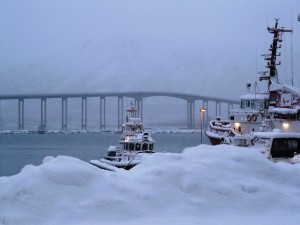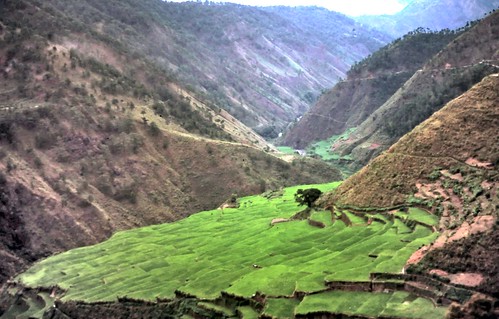Meet the first GLOBAL IDEAS ambassador
At the end of his filming trip to the Philippines, our reporter Carl Gierstorfer talked to one of our first GLOBAL IDEAS ambassadors. Read Carl's final dispatch from Manila:
"Meet Eric Raymundo, an engineer and environmental practitioner here in the Philippines. Eric caught our attention because he is such an enthusiastic follower of the Global Ideas project. Eric's enthusiasm is rooted in his deep concern for nature and a sustainable way of living. A former scuba diver, Eric now consults businesses in the Philippines on how to save energy and resources; eventually he wants to build a network of zero carbon tourism resorts in the Philippines. His work is part of the Switch-Asia project, funded by the European commission and carried out in collaboration with the Center for Appropriate Technology at Vienna University of Technology.
In this little movie you will hear about Eric's realistic approach to getting things done; his concerns about global warming and his idea for a cooler world. Enjoy."
Meet the United Nations Volunteers of Cambodia
Last month GLOBAL IDEAS spent some time with the United Nations Volunteers in Phnom Penh, the capitol of Cambodia. Here the volunteers were celebrating the 10th anniversary of the International Year of Volunteers (IYV+10). Our reporter Marion Hütter had the chance to talk to some of the volunteering young people who are coming to Cambodia from all over the world to help and to learn a lot.
Here are some pictures Marion brought back from Phnom Penh:
The Gateway to the Arctic?
 I have just about thawed out enough to write this, having spent a couple of hours taking pictures and recording sound in the beautiful but chilly twilight of an Arctic afternoon in January. I’m reporting for Deutsche Welle from "Arctic Frontiers". Now what does that bring to your mind? Northern countries squabbling about territory? Or the frontiers posed by snow, ice and extreme conditions to all but explorers, adventurers and the hardiest of scientists? A conference is probably the last thing that comes to mind – unless, like me, you are into the science and politics of the Arctic region.
I have just about thawed out enough to write this, having spent a couple of hours taking pictures and recording sound in the beautiful but chilly twilight of an Arctic afternoon in January. I’m reporting for Deutsche Welle from "Arctic Frontiers". Now what does that bring to your mind? Northern countries squabbling about territory? Or the frontiers posed by snow, ice and extreme conditions to all but explorers, adventurers and the hardiest of scientists? A conference is probably the last thing that comes to mind – unless, like me, you are into the science and politics of the Arctic region.
 Every year at this time, when people in the Arctic celebrate the "return of the sun" after the long dark Northern winter (it stays light from around 9.30 until nearly three at the moment), the Arctic Frontiers conference brings scientists, politicians, decision-makers, students and NGOs to Tromsö, two hours flight from the Norwegian capital Oslo and in the Arctic Circle. The town likes to be known as Norway’s "gateway to the Arctic". Historically, it has been the base for Arctic expeditions and still is. A lot of the more "comfort-loving" travellers who pass through nowadays are tourists on cruise ships. And the way the climate is changing, Tromsö is likely to be the departure point or maritime "crossroads" for a lot more travellers – and a lot more goods, in the not too distant future.
Every year at this time, when people in the Arctic celebrate the "return of the sun" after the long dark Northern winter (it stays light from around 9.30 until nearly three at the moment), the Arctic Frontiers conference brings scientists, politicians, decision-makers, students and NGOs to Tromsö, two hours flight from the Norwegian capital Oslo and in the Arctic Circle. The town likes to be known as Norway’s "gateway to the Arctic". Historically, it has been the base for Arctic expeditions and still is. A lot of the more "comfort-loving" travellers who pass through nowadays are tourists on cruise ships. And the way the climate is changing, Tromsö is likely to be the departure point or maritime "crossroads" for a lot more travellers – and a lot more goods, in the not too distant future.
 The melting of the Arctic sea ice, a lot faster than anticipated, is making the remote wilderness of this ecologically fragile region much more easily accessible. US rear admiral Dave Titley said in a presentation here the US navy reckons with a whole month of summer with no sea ice as early as 2030. That date has been continually coming forward in recent years. The question is what it will mean for the Arctic – and the rest of the planet. "Arctic Tipping Points" is the title of this year’s conference – which goes on for a whole week, with a political and a science segment. The Arctic plays a key role in regulating the world’s climate. Scientists are trying to work out when key factors – like the melting of the sea ice, which also acts as a protective cover, reflecting heat from the sun back up and away from the earth – could reach a "tipping point", or point of no return, triggering further warming as the darker ocean absorbs more heat. One study quoted here says 6 of 14 elements identified as "tipping elements" in the "earth system" are located in the Arctic.
The melting of the Arctic sea ice, a lot faster than anticipated, is making the remote wilderness of this ecologically fragile region much more easily accessible. US rear admiral Dave Titley said in a presentation here the US navy reckons with a whole month of summer with no sea ice as early as 2030. That date has been continually coming forward in recent years. The question is what it will mean for the Arctic – and the rest of the planet. "Arctic Tipping Points" is the title of this year’s conference – which goes on for a whole week, with a political and a science segment. The Arctic plays a key role in regulating the world’s climate. Scientists are trying to work out when key factors – like the melting of the sea ice, which also acts as a protective cover, reflecting heat from the sun back up and away from the earth – could reach a "tipping point", or point of no return, triggering further warming as the darker ocean absorbs more heat. One study quoted here says 6 of 14 elements identified as "tipping elements" in the "earth system" are located in the Arctic.
Other speakers – like the Rear Admiral – have other interpretations of "tipping points" – like the Arctic "tipping" from being a remote inaccessible area into a mainstream region for (literally) "business as usual". Well not quite as usual. This remains a harsh and dangerous environment. But the business opportunities are definitely there. And what do the conservationists, NGOs and indigenous communities up here have to say about all this? Join me for regular updates on the Ice Blog.
Abandoned wonders
Our reporter Carl Gierstorfer has finished filming for his upcoming report on sustainable rice crops in the Philippines. Read his latest post from the field:
"The Filipinos call them the 8th world wonder, UNESCO lists them as a world heritage site: the rice terraces of the Cordillera mountains in northern Luzon. The Ifugao people started to carve them into the hillsides 2000 years ago, at a time when iron hadn't been discovered in their part of the world. Instead they used hardwoods collected in the forests; they built complex irrigation systems and transformed these mountainous forests into a rice growing region.
One cannot stop wondering about why the Ifugao people, apparently feared headhunters, took so much effort to grow rice. Were the forests hunted empty? Was it prestigious to grow rice? What's for sure is that the climate here, even in the present cooler and drier season, is not pleasant. It's damp, wet, and pretty cold at night. The terraces are still farmed today, the plots of land handed down the generations. It is tough work. During the rainy season landslides destroy many rice paddies. Small wonder, then, that more and more of the fields are being abandoned; young people move to the cities, get jobs in the tourism industry. After all, it takes almost a year's work to harvest rice that will last for only a few months. As spectacular as these rice terraces are, there is nothing romantic about farming them. One can only hope that after 2000 years there will be at least some people left who will maintain this 8th wonder of the world.
We have finished filming and head back to Manila. There is lots of material – so now it's all about choosing the most interesting bits for the report."
Rice – staple crop and climate killer?
Our reporter Carl Gierstorfer is currently filming in the Philippines for his upcoming report on sustainable rice production: Here is his third dispatch from the field:
 "There are a lot of challenges ahead to adapt the world's most important crop – rice – to the consequences of climate change. Fortunately scientists got some smart ideas. But you might be surprised that rice farming itself has a negative impact on the world's climate. Not the plant is the problem, but the method in which it is grown. Rice (a sort of grass) needs a lot of water to grow. In fact, farmers flood their fields during the farming season, so that a fair part of the plant is submerged. This has many advantages; it keeps pests at bay, recycles nutrients and so on. But there is a downside. In these oxygen-depleted conditions bacteria grow that emit methane, a powerful greenhouse gas. In rice producing countries, the total emissions of methane make up a significant part of greenhouse gas emissions.
"There are a lot of challenges ahead to adapt the world's most important crop – rice – to the consequences of climate change. Fortunately scientists got some smart ideas. But you might be surprised that rice farming itself has a negative impact on the world's climate. Not the plant is the problem, but the method in which it is grown. Rice (a sort of grass) needs a lot of water to grow. In fact, farmers flood their fields during the farming season, so that a fair part of the plant is submerged. This has many advantages; it keeps pests at bay, recycles nutrients and so on. But there is a downside. In these oxygen-depleted conditions bacteria grow that emit methane, a powerful greenhouse gas. In rice producing countries, the total emissions of methane make up a significant part of greenhouse gas emissions.
Now here is the challenge: feed ever more people with rice, make farming more productive, but reduce emissions of greenhouse gases. Impossible? There is a way to get rid of the gas-emitting bacteria and even save precious water along the way. It is a simple method that scientists now try to bring to the farmers. How exactly this works, you will find out in my report.
We have traveled a fair deal now: from Manila south to the International Rice Research Institute (IRRI), then up north to the granary of the Philippines – the region of Nueva Ecija. We then headed to northern Luzon, to the Sierra Madre mountain range. Here are the famous rice terraces, carved into the hillsides by farmers some 2000 years ago. A UNESCO world heritage site – and topic of my next entry…"
(image thanks to CanadaGood @flickr)








Feedback